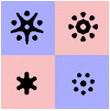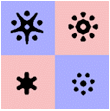Designer lattices
Designing particles that self-assemble because of the interactions between them is a bottom-up approach to making complex miniature structures. Although particles can now be shaped or chemically altered to have many kinds of interaction with one another, experimentalists can’t often predict what structures will form once these particles come in contact. A pair of papers appearing in Physical Review Letters offers theoretical guidance that may aid in the future design of particles for self-assembly.
Theoretically, it is easier to target a particular structure, and figure out what the interactions between the particles need to be to get it, than the other way around. Most such approaches use simulations to iterate toward a solution, but Erik Edlund and his colleagues at Chalmers University of Technology in Sweden have developed a new method to solve the problem directly. Instead of describing particle interactions in real space, they work in reciprocal space and find the particle-particle potential that gives a targeted geometry as a unique ground state. As a proof of principle, they find the potential needed to produce a kagome lattice, where the particles form a lattice of interconnected triangles.
Another paper from the same group explores the flip side of self-assembly: Given a certain type of particle-particle interaction, what structures can form? To address this question, Edlund et al. developed a method for solving, analytically, a model which predicts the minimum energy structure for particles that have an isotropic, pairwise interaction with one another. They show that such a potential results in a limited “alphabet” of possible structures. – Jessica Thomas





